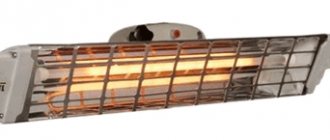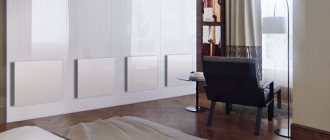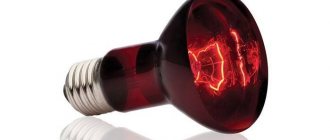Due to the numerous advantages, the demand for infrared heaters is increasing every year. With their help, you can quickly and efficiently warm any residential and industrial premises. IR heaters generate significantly more heat than many other heating devices. For example, fan heaters. In addition, this type of climatic technology does not burn the oxygen present in the room. According to the assurances of manufacturers, the harm of an infrared heater to human well-being is insignificant. But the practice of use and the research carried out do not fully confirm this.
What is IR radiation
Any household heating appliance emits a certain amount of infrared radiation. This even applies to conventional steam heating radiators. But when using infrared heating devices, their frequency and wavelength are much higher.
Infrared radiation is one of the types of electromagnetic fluxes. The most powerful natural source of such radiation is the sun. But despite this, being under the rays of the sun is not dangerous for humans.
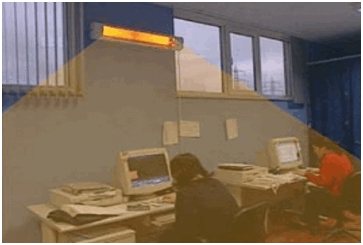
Attention: The rays of heat, during the operation of the IR heater, are directed to the desired area of the room and evenly heat it.
With these devices, only certain areas in the room can be warmed. Radiated waves are of the following types:
- Short. Their length is 0.76 - 2.5 microns, and the element temperature is not less than +800 degrees.
- Average. Long 50 microns, and the temperature is about +600 degrees.
- Long. Their length is 200 microns, and the temperature is +300 degrees.
If the instructions are not followed, infrared heaters are harmful to health, because their radiation can penetrate into human skin. The depth of exposure to the skin largely depends on their intensity. Waves arising during the operation of an IR heater are of three following categories:
- IR-C - characterized by an insignificant effect on the human body. Their length is equal to 3 microns. The effect is on the surface of the skin.
- IR-B - lengths from 1.5 to 3.0 microns. These waves penetrate only the surface layer of the skin.
- IR-A - these waves have the deepest penetration. Their length is from 0.76 to 1.5 microns. The penetration depth is approximately 4 centimeters.
During the operation of the IR heater, waves of various sizes are formed. In this case, the number of certain rays may be different. But as studies show, the higher the heating temperature, the more short waves there will be.
Much also depends on the material from which the radiating surface of this heating device is made. The black heated surface has the greatest negative impact. If the body is made of ceramic materials, then the strength and frequency of radiation is much lower.
Infrared radiation
The word "radiation" can scare ordinary people, since we all know about the adverse effects of radiation or X-ray waves. However, when it comes to infrared light, you shouldn't be afraid. We do not notice it visually, since the wavelength is higher than the visible spectrum, but we can feel the heat.
It is worth noting that infrared radiation has long been used by physiotherapists to treat colds and stimulate the activity of the gastrointestinal tract. The range used by specialists is from 5 to 15 microns. It is in this interval that household infrared heaters work.Consumer reviews prove that when using such devices, the incidence of both adults and children is significantly reduced, and fungal diseases pass in indoor plants.
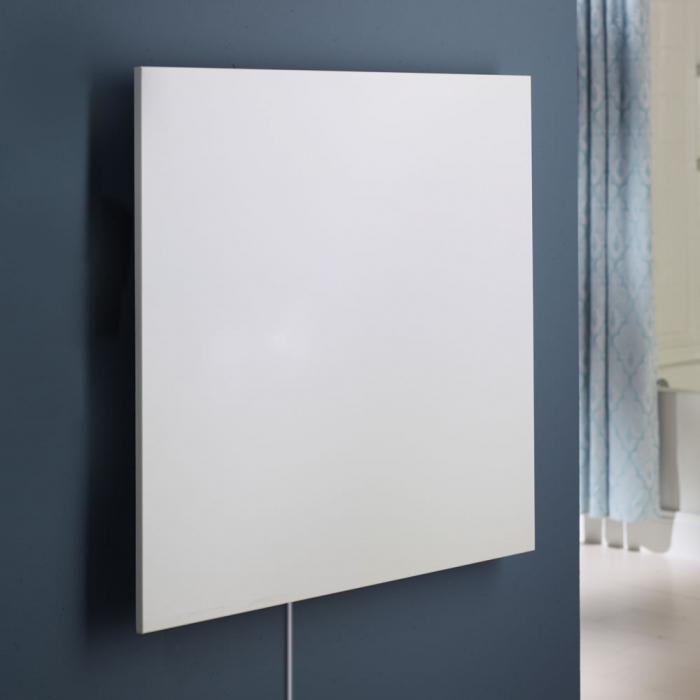

Infrared radiation harm
The issue of the negative impact of infrared radiation on humans has occupied many leading scientific and medical figures. Numerous studies have been carried out which have shown that these heaters are capable, in some cases, of negatively affecting human health.
Attention: The greatest harm from infrared heaters is associated with overdrying of the skin, which heats up very quickly, after which moisture evaporates, which the body is not able to quickly restore.
If you are in close proximity to such a heater for a long time, you can get burned. Indeed, at a short distance, this heating device emits waves that are the most dangerous.
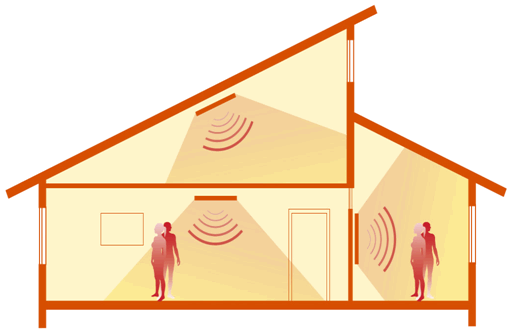

Infrared radiation is always available in any production. People, being in the workplace, a person is regularly exposed to it. If the skin is not protected by clothing, then with daily exposure, changes occur within its structure. In particular, the permeability of the cell membranes decreases, the protein melts, which is irreversible, and the appearance of the blood cells changes.
The eyes also suffer from radiation. Especially the retina and lenses. Because of this, vision may deteriorate. In addition, cataracts may occur in the future.
To heat various objects on the street, heaters are most often used that emit short or long waves. They can be installed in gazebos, cafes, summer areas. If such a device is installed indoors, a person who is regularly exposed to radiation can get quite severe burns. Often, skin redness and blisters appear.
Harm
However, in addition to the advantages, like all other heaters, IR have their own disadvantages:
- Drying of the skin is felt with prolonged exposure to infrared radiation. The body cannot cool the heated areas, as a result of which a person can get burned.
- Also, long-term perception of the emitted rays by a person produces intracellular changes. For example, there is a risk of burns to the lens of the eyeball and the subsequent development of cataracts.
- An excessively low position of the emitter causes severe headaches, similar to those obtained with sunstroke.
Advice:
- It is not recommended to leave the heater on during sleep and place it in the children's room.
- When used outdoors, the harmful effect on the body is minimized as much as possible.
In order to make a decision for or against IR heaters, it is important to understand what IR radiation is and what is the principle of operation of devices.
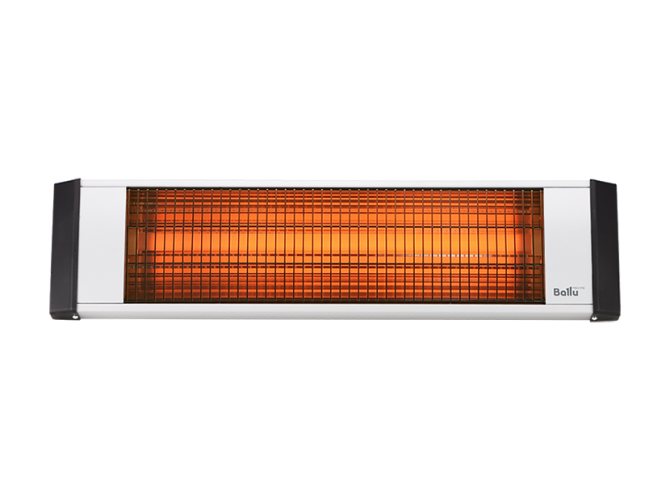

Infrared protection methods
In order to understand whether an infrared heater is harmful or not, you need to familiarize yourself with the methods of protection against their radiation. There are several effective methods on how to reduce the negative impact of infrared heaters on the human body. Much depends on the correct choice of the heater and the place of its installation:
- Do not install an IR heater in a children's room or bedroom. If for some reason this cannot be done, then he should be directed to an area in which people are not constantly present. In no case should radiation from it fall on the bed, since then the person will be exposed to constant exposure to radiation.
- It is best to install an IR heater in the far corner of the room or under the ceiling. Such an arrangement will allow high-quality heating of the room and protect people from direct exposure to radiation.
- You should not buy infrared heaters with too much power for heating living quarters. As the practice of their application shows, it will be enough for it to heat only the ceiling, floor and walls with high quality. They, in turn, will transfer heat to the room.
- When choosing a heater, you should give preference to quality models. When buying a cheap product, you risk not only that it will quickly fail and will not be able to perform the functions assigned to it, but also your health. Indeed, when heated, harmful substances will enter the atmosphere of the room. The safest are tubular, ceramic and carbon infrared heaters.
- Before purchasing an infrared heater, you should carefully read its performance characteristics. Find out all the details related to its operation. This information can be obtained from consultants or found on the Internet. It will not be superfluous to read reviews about it.
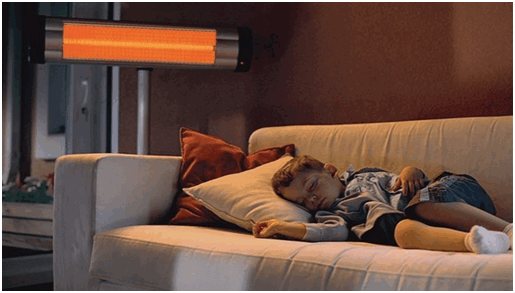

If you follow these rules, you can not only quickly and effectively warm the room, but also protect yourself from the negative effects of infrared rays on the human body.
Infrared heaters
This is a device whose actions are aimed at heating a room or a certain space. Heating from such a heater occurs under the influence of infrared radiation.
As heating elements, depending on the heater model and the manufacturer's company, there can be:
- Quartz lamps.
- Halogen lamps.
- Carbon lamps.
- Heating element with a radiating plate.
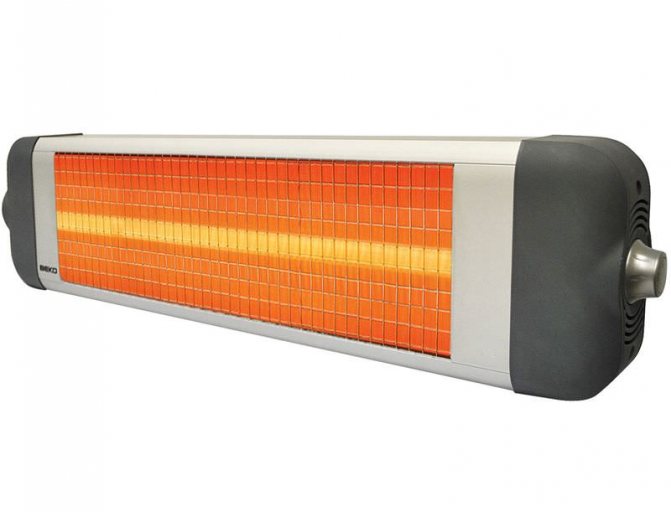

IR heaters are equipped with two types of diffusers:
- Flat in shape, the flow of rays is directed strictly in a straight line, therefore the heated area is limited.
- Curved design, radiation spreads in space at an angle of up to 120º, which significantly increases the heating area.
The diffuser plates are available in two types of coatings:
- Ceramic - white.
- Anodized gray.
You should not overpay for a ceramic coating, since the effectiveness of the plates is almost the same.
Principle of operation
The principle of operation of infrared heaters is borrowed from the Sun. Therefore, the methods of heating rooms, open or semi-open areas are fundamentally different from the usual heat sources.
They are as follows:
- The applied electrical voltage is converted into infrared radiation by means of a heating element.
- The emitted infrared rays pass through the diffuser grating. Objects around absorb them, thereby heating them up.
- Heated objects (furniture, floors, walls, etc.) radiate heat and heat up the surrounding air.
- The temperature is regulated by a thermostat.
- Warm air rises from the floor upwards, thus the heat flow is at the bottom of the room.
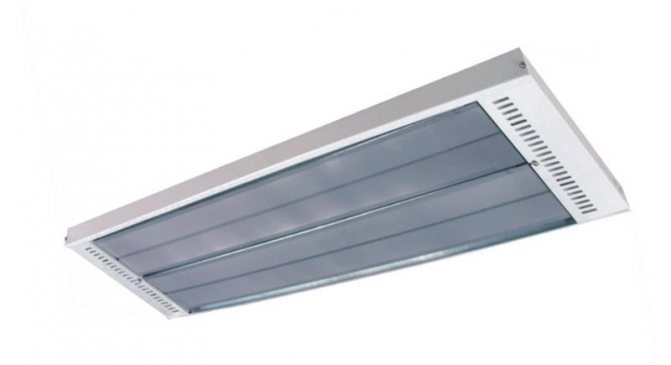

User reviews
- Igor, St. Petersburg. I have been using IR heaters for two years now. During this time, I purchased several pieces for each room. Initially purchased as additional heating, now almost completely switched to heating the house with these heat sources. The cost savings are tangible.
- Alexander, Krasnoyarsk. I bought it a year ago and is happy with my purchase. Always comfortable temperature from +18 to + 22ºС. The whole family and guests are delighted. I recommend it to everyone, you will not regret it.
- Anna, Moscow. For quite a long time, they persuaded the boss to buy such a heater for the office. As a result, we purchased, but did not calculate the power, it is not enough for the whole room. There are no questions about the heater itself, it works silently in the heating zone, warm and comfortable.
- Boris, Rostov-on-Don. He built a dacha outside the city, and for a long time could not decide on heating in cold weather. I decided to buy an IR heater and did not regret it, the bed, the floors are always warm, the savings are tangible.
- Evgeny, Moscow. I got such a heater for a car wash. The workers are happy and satisfied.In winter, cars dry in 7 minutes, the floor does not freeze. A very good heater and most importantly economical.
In general, judging by the reviews of Internet users, by purchasing an infrared heater, you can get an economical, environmentally friendly and rather effective source of heat.
When can IR devices be harmful?
Returning to the question of infrared heaters - are they harmful or not, we note that if the range of infrared rays does not go beyond the permissible limits, they are absolutely safe. But this is only if the manufacturers do not violate production standards.
Effect of infrared radiation on the skin
Human health damage to an infrared heater is possible when the device emits medium-wave or short-wave rays. If you are exposed to the wrong IR waves, your skin heats up. The depth of penetration depends on the wavelength:
- Long-wave rays act on the stratum corneum of the skin without causing harm to health.
- Medium-wave rays are able to penetrate the upper layers of the skin, causing it to dry out. The skin loses its elasticity, becomes covered with fine wrinkles and begins to peel off.
- Short-wave rays, penetrating under the skin to a depth of 4 cm, with prolonged exposure can cause first and second degree burns - redness or blisters.
Attention! Shortwave and mediumwave devices can damage your skin and cause burns.
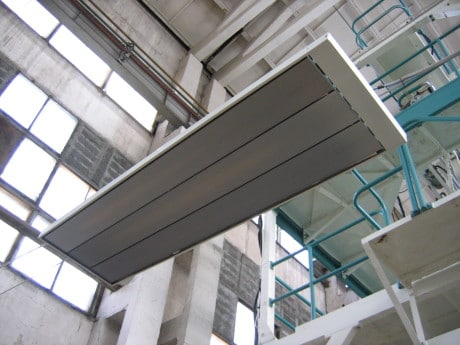

Powerful halogen IR devices are installed in large public spaces
Effect of short and medium IR waves on the eyes
Not only the skin is exposed to the rays, but also the eyes. The retina is a photosensitive tissue composed of protein substances that harden and coagulate when exposed to high temperatures. The same happens with the lens of the eye.
It follows from the above that the use of IR heaters with medium and short waves is fraught with eye disease and visual impairment. With constant exposure to "wrong" rays, cataracts can develop. Prolonged stay in a room with an IR device turned on can cause headaches, as being under its influence is similar to the fact that you are with your head uncovered in the scorching sun for a long time.
Attention! Non-standard infrared heaters can cause visual impairment and eye disease. An incorrectly selected device causes headaches.
The use of substandard materials by the manufacturer
Can an infrared heater be harmful to a person if you have foreseen everything and have chosen a model in accordance with the recommendations? Unfortunately, it can, if the manufacturer turned out to be unscrupulous and used low-quality materials. When heated, they release harmful substances. They cannot be seen or felt. The negative impact is expressed in the deterioration of well-being and health.
Important! Recent scientific research has confirmed the positive effect on human health and immunity of long-wave rays, but only with short-term exposure!


Rational use of infrared technology excludes harm to humans
Benefits of IR Heaters
Research on whether infrared heaters are harmful to humans have shown that they are not only harmless, but also useful. Long-wave infrared radiation has a detrimental effect on pathogens. This property is actively used in medicine. IR lamps are used in:
- therapy;
- surgery;
- dermatology;
- dentistry.
An infrared heater in your home will strengthen your immune system and protect against colds and other diseases caused by viruses and bacteria.
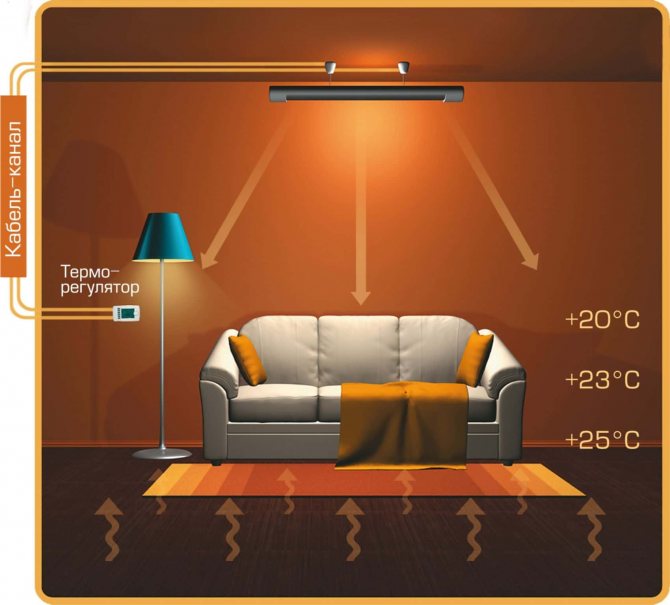

Warm air concentrates on the floor and walls
Other advantages of infrared heating technology:
- Do not dry out the air, as the steam remains in the air. This has a beneficial effect on the mucous membranes that block the path of pathogenic microbes.
- Oxygen molecules are retained in the air, making it easy to breathe. They do not burn out like when using fireplaces or other appliances.
- A warm zone forms on the floor. The higher the ceiling, the lower the temperature. This makes it possible to always keep the feet warm, while the head remains cold.
Important! Infrared radiation is a method of heat transfer with instant heating of objects falling into the zone of its action. As the walls and floor heat up, they give up their heat to the air, the temperature of which will decrease as it moves away from the surface of the walls and floor.
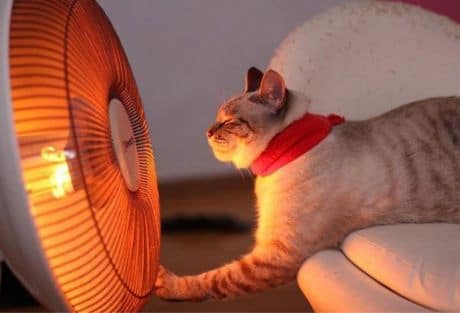

The design of modern fireplaces is carefully thought out, does not pose a danger to children and pets
What is harmful in infrared heaters
1. IR radiation, acting on our skin for a long time, dries it out. Moisture evaporates from the skin, it heats up very quickly (and only its upper layer), and sweat does not have time to form. Therefore, on the side of the body that faces the heater, a burn may appear. This can happen if the appliance is installed in a room.
2. Research into the effect of infrared rays on humans has been going on for a long time. For medicinal purposes, this radiation is used in time-limited physiotherapy procedures. But production, in which such radiation is constantly present, is considered to be harmful.
Skin that is not protected by clothing can undergo internal changes under strong influence of infrared rays. In proteins, denaturation processes begin, cell membranes lose their permeability, as a result of which changes occur in blood cells. The retina and lens can be burned, and then there is a risk of cataract disease. Keeping in mind the dangers to the health of infrared heaters, you must adhere to certain standards when using them.
3. If an IR heater is fixed to the ceiling in the room, and low enough, then it will constantly heat the scalp. Therefore, if you really want to buy a ceiling heater, hang it higher. And direct it so as not to be constantly under its rays. And in a sleeping room or in a nursery, you should not use such devices at all.
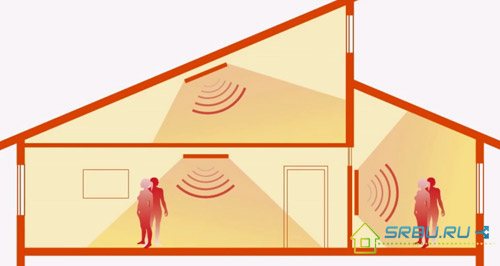

If you cannot do without this, then choose a low-power device, and direct the emitting side to the walls, floor or furniture.


